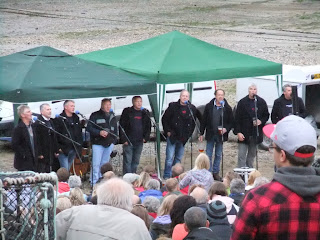At the end we had to look at each other and say "So, what was the best part?" Here are our answers.
For now......
1 1)
Twelve-year-old Seb’s (short for Sebastian)
Fifth-Largest-in-Cornwall Old Lawnmower Museum.
Kept in his father’s shop, in its own special room. They are carefully
arranged on shelves along all four of the walls. He is prepared to explain the heritage of each
mower, how it was restored or what it needs.
He accepts donations and proudly poses with his (trust us) pretty darn
impressive collection of reel mowers going back to the 1800’s, including one
that’s been to India and back. It was
used to mow cricket pitches.
 2 2)
The picture-postcard-perfect Port Isaac that is
better than what we’ve seen on TV and the internet. We’re tried and tried and can’t take a bad
picture there. Or the same one twice. We
sigh wistfully just thinking about such a charming town so rich in history.
2 2)
The picture-postcard-perfect Port Isaac that is
better than what we’ve seen on TV and the internet. We’re tried and tried and can’t take a bad
picture there. Or the same one twice. We
sigh wistfully just thinking about such a charming town so rich in history. 3 3)
The grooves cut into the corners of the stone
buildings by the old lifeboat when it was wheeled down through the village into
the sea for rescues.
3 3)
The grooves cut into the corners of the stone
buildings by the old lifeboat when it was wheeled down through the village into
the sea for rescues.
4 4)
The high proportion of Cavalier King Charles Spaniels
that make up the impressively high number of spoiled, pampered, and otherwise
family-ized dogs all over Cornwall. We see in the paper that some little white
terrier has won Britain’s version of “America’s Got Talent.” Apparently that’s
okay with everyone because now the question of whom (what?) to breed him to
looms in the papers. Maybe next season a
Cavvie will win.


5 5)
The ease with which one can be served an
unending variety of all-new-to-us Cornwall beer and cider. For two weeks. And we really didn’t make a dent in it or
drank a beer out of pity for the brewer.
 |
| Cornwall Sports Bar Events: Grand Prix and Wimbledon |
6 6)
The number of people who apologized to us for
the rain. In a land that sees a lot of
it, that’s called empathy. With tourists, no less. The rain kept us indoors
only one day. And much of the moisture in the sky isn’t really rain, more like
a gentle mist – tourists should be told it’s good for the skin.
8 8)
The old chap in the Padstow Museum who talked to
us about the history of the Cornish diaspora and where they now live in the US
and the rest of the world. He was a charmer.


 |
| Everyone Came Out to Hear the Fishermens' Friends |
 |
| The Old Schoolhouse as Restaurant |
1 10)
Feeding an all-day wood fire in our stone cottage’s
fireplace at Kennall Vale and reading about English herbs, and Cornwall history
and watching it rain, rain, rain while the water gushed down the mill race
outside the window. Heaven. And we had
plenty of wine and Cornwall fudge and cheese to snack on.
1 11)
Buildings made of stone or granite block, with
slate roofs and floors; wooden beams above the windows and doorways and hand-wrought
iron latches. And bathroom and pantry doors two inches thick, with ising glass
peep holes, from the Bodmin Jail in our Kennall Vale cottage.
1 12)
Walking the coastal paths with the sea crashing
against the steep rocky cliffs on one side and a soaring grassy hillside
covered with wildflowers on the other. And sitting on the benches on Roscarrock
Hill to look out over Port Isaac harbor; the same place that we were entranced
by in Doc Martin.
 1 13)
Clotted cream.
It’s better than it sounds and is great as a base for famous Cornwall
fudge and ice cream.
1 13)
Clotted cream.
It’s better than it sounds and is great as a base for famous Cornwall
fudge and ice cream.
1 14)
The to-die-for lamb shank slow-cooked in
rosemary/mint sauce at the Seven Stars Inn in the tiny town of Stithians. Served with a fork because that’s all you
need. We ran out of food objects to sop up that marvy sauce with. The owner’s dog got the last licks in. Lucky dog.
1 15)
Foot paths and bridle paths everywhere,
signposted and mapped. Instead of
complaining about everyone in Kentucky being fat, we could get busy with some
policies that help create public access to all the lovely space in Central
Kentucky. Oops, sorry. Slipped into lecturing there.
 |
| Fonthill Bishop |
 |
| Diner at Fonthill Bishop |
1 17)
Having the rest of the return trip go
unexpectedly well, including finding the rental car return in the roundabout maze
that is Heathrow, on the first try, (with the help of the Droid GPS), then discovering our hotel is hooked to
our departing concourse so we can just walk over in the morning, then getting an upgrade at the hotel so
we can lounge in their lounge, drink their liquor and eat their food all
evening, then have a Full English
breakfast served in the Heathrow Delta Club the next morning, and finally having the helpful gate agents
in Boston toss us on an earlier flight to Cincy, in First, at the last minute,
to save us a 5 hour layover. And bundle us along and promise to
deliver our luggage to the house. Sweet.
 |
| Squeeze Belly Alley in Port Isaac. |







































